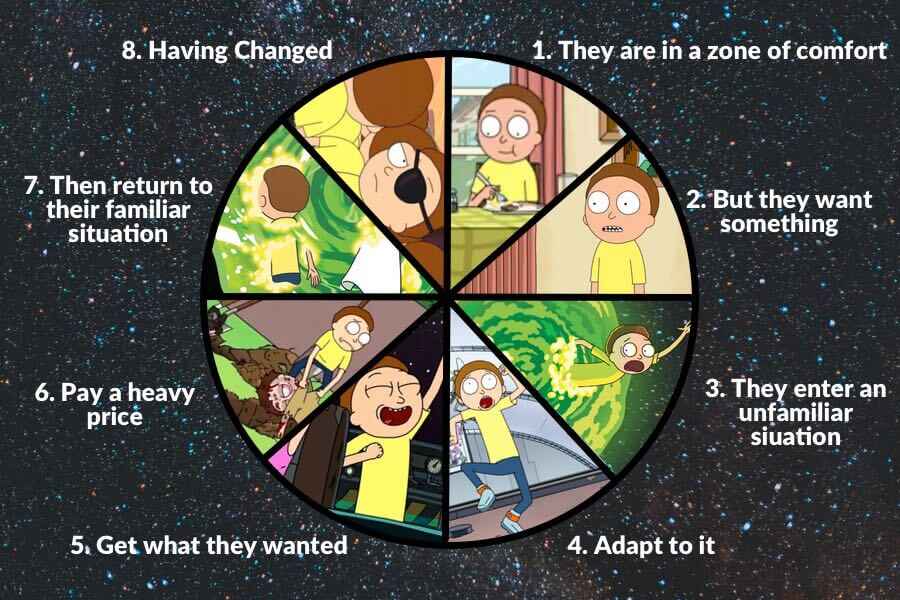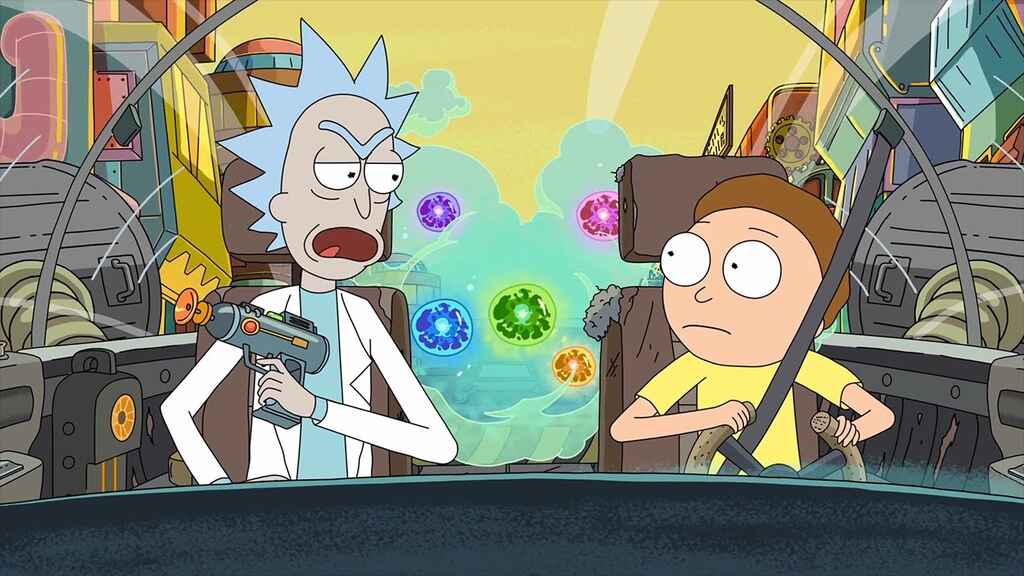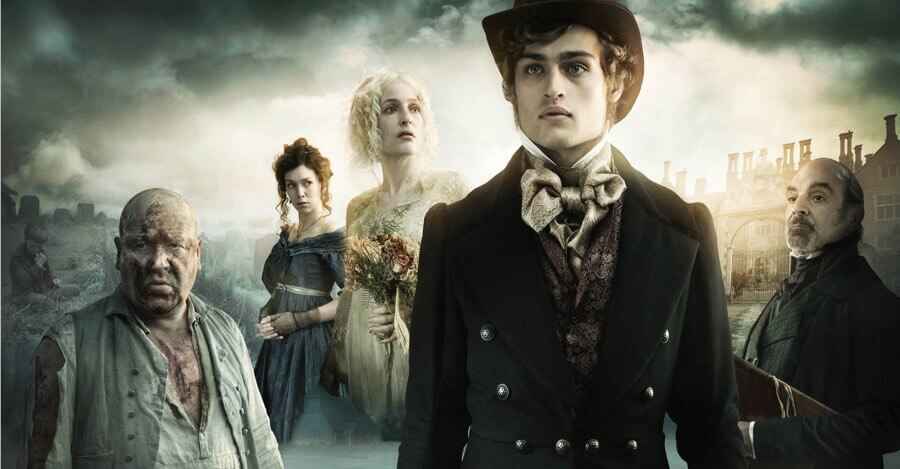
Reedsy's editorial team is a diverse group of industry experts devoted to helping authors write and publish beautiful books.
Head of Content at Reedsy, Martin has spent over eight years helping writers turn their ambitions into reality. As a voice in the indie publishing space, he has written for a number of outlets and spoken at conferences, including the 2024 Writers Summit at the London Book Fair.
The Dan Harmon Story Circle, also known as “The Embryo”, is an approach to plotting developed by TV writer Dan Harmon. It follows a protagonist through eight stages, beginning with the character being in their comfort zone, then venturing out into the unknown to seek something they want. The character achieves their desire, but at a great cost, and ultimately returns transformed by what they’ve experienced.
This narrative framework is applicable to a wide range of genres and forms, and is a great way to structure any story that focuses on character development. This post contains a breakdown of the individual steps, gives examples of the Story Circle in action, and explains why it’s such an invaluable template for writers.
This particular story structure is adapted from the monomyth, also known as The Hero’s Journey — which itself derives from the work of academic Joseph Campbell. The Story Circle lays out a kind of narrative arc that's commonly used by myths from all over the world and emphasises how almost all forms of storytelling have a cyclical nature. In broad strokes, they always involve:
The Story Circle functions similarly — so, you may ask, why not just use the original? In short, Campbell’s system is more complex (11-steps), and alludes to a particular type of story, namely high fantasy (think knights, wizards, potions, and swords in stones). What Harmon did was streamline this process to just eight steps, and broaden them out to be less genre specific. The benefit of Harmon’s version over Vogler’s is that it focuses more specifically on character and is much easier to apply to a wider range of stories.

The steps are comprised of basic human motivations, actions, and consequences, which he lays out in a circle:
You might be asking why Harmon doesn’t just lay this structure out in a flat line. When asked about this, he points to the rhythms of biology, psychology, and culture as his inspiration: how we all move cyclically through phases of life and death, conscious and unconscious, order and chaos.
The fascinating thing he points out is that cycles like these are, in part, what have allowed humans to evolve.
“Behind (and beneath) your culture creating forebrain, there is an older, simpler monkey brain with a lot less to say and a much louder voice. One of the few things it's telling you, over and over again, is that you need to go search, find, take and return with change. Why? Because that is how the human animal has kept from going extinct, it's how human societies keep from collapsing and how you keep from walking into McDonald's with a machine gun.”
“We need [to] search — We need [to] get fire, we need [to find a] good woman, we need [to] land [on the] moon — but most importantly, we need RETURN and we need CHANGE, because we are a community, and if our heroes just climbed beanstalks and never came down, we wouldn't have survived our first ice age.”
What Harmon's getting at is that stories are a basic, universal part of human culture because of their millennia-long history as both a teaching and a learning tool. This idea of questing, changing, and returning is not a hack concept concocted by lazy writers, but an ingrained part of our collective psyche. That’s why stories from one culture are able to resonate with people across the world.
In Harmon’s philosophy, when a book, film, show, or song doesn’t meet the criteria above, it’s not necessarily bad writing: it’s simply not a story.

Now that we’ve got the background, it’s time to get into the meat: what are the steps of the Story Circle, and what do they entail.
Here are the Story Circle’s 8 steps:

There's perhaps no better example of this system in action than the sci-fi comedy series, Rick and Morty, which Harmon co-created. Known for its fast-paced, pop-culture-inflected humor, affection for science fiction tropes, the show has also been praised for its dense storytelling, often fitting in a feature film’s worth of plot within a modest 21-minute runtime.
In the video below, Harmon applies the story circle to an episode of Rick and Morty entitled “Mortynight Run.” For enough context to understand the clip, here’s some background info:
Rick is a mad, drunk, egomaniacal scientist who has invented a portal gun that allows him to have debauched adventures across time and space. He almost always drags his sensitive, anxious grandson Morty along for the ride. In this episode, they also bring along Morty’s father, Jerry, for whom Rick only has disdain.

Let's take another look at how the episode’s “A” story — which centers on Morty's journey — fits into the story circle.
The first beat of the story sees Rick and Morty on what seems like just another one of their adventures, flying through space with Jerry in tow. Things take a turn when Rick takes a call to organize a shady deal, and unceremoniously dumps Jeff from their spaceship.
It becomes apparent that Rick is carrying out an arms deal, selling weapons to an assassin to pay for an afternoon at the arcade — much to Morty’s dismay.
As Harmon points out, “This is an ethical quandary for Morty.” The boy is put in a situation of guilt that compels him to “go across a threshold and search for a way to undo the ethical damage that he perceives Rick as doing.” Putting things right is Morty’s “want”, which takes us to the next stage.
Even though he rarely defies his grandfather’s instructions, Morty takes Rick’s car keys and chases after the assassin, accidentally killing him in the process. He’s now trapped in an Intergalactic Federation outpost.
Morty discovers an alien gas entity named ‘Fart’ — who was the assassin’s target. Going against Rick’s instructions once more (and making what he believes to be the ethical choice), Morty liberates Fart from space jail and they make their escape.

Morty has achieved his goal: he’s saved a life, and stopped a prolific assassin — and can now rest assured that he’s done the right thing.
“In the second half of the story, we start finding out that the act of saving that life is going to cost a lot of other people their lives,” Harmon explains. Bounty hunters and law enforcement are seeking the group, and Fart slaughters many space cops and innocent bystanders while Rick and Morty make their escape.
After the escape, the gang returns to a place resembling ‘normal life’, a phase Harmon refers to as “crossing the threshold” (here metaphorical, rather than a literal return home). At this point, Morty realizes that Fart is a truly malevolent creature and means to return with his people to destroy all carbon-based life.
Note: On the Circle diagram, Step 7 (the return) is directly opposite to Step 3, where Morty first crossed the threshold into the unfamiliar situation. Balance and harmony are a big part of Harmon's approach to storytelling.
“So Morty makes the decision to change into someone who kills.” Realizing that his belief that all lives must be saved is not an absolute truth — some are simply malevolent — he terminates Fart, thereby saving the universe and becoming someone different from the person he started as. As Harmon points out, this is not a show for kids: not all protagonists need to learn universally positive messages for a story to ring true.
Harmon has laid out his process for using the story circle in a fascinating set of posts (warning: contains swears) where he also talks about the nature of storytelling, answering questions like…

According to Harmon, the beauty of the Story Circle is that it can be applied to any type of story — and, conversely, be used to build any type of story, too.
“Start thinking of as many of your favorite movies as you can, and see if they apply to this pattern. Now think of your favorite party anecdotes, your most vivid dreams, fairy tales, and listen to a popular song (the music, not necessarily the lyrics).”
So let’s put that theory to the test. Let’s pick an example that’s far removed from Harmon’s own work see if it applies: Dickens’s Great Expectations.
Although Great Expectation was a serial, written week-by-week, Dickens must have consciously or unconsciously been aware of this cycle, or something like it. He sent his characters on a journey towards something they wanted — only for them to pay the price and return home, changed.
As with any sensible advice about structure, the takeaway here is not that you must slavishly adhere to a set formula or risk ruining your story. This story circle, along with other popular story structures, are simply tools based on observations of stories that have managed to resonate with readers over the centuries. They can also be a great tool to know what should come next, and to pace yourself within your story — if you’re halfway through and still in the comfort zone, you know you need to make some changes.
There are, of course, plenty of other options for story structure, which you can learn about by reading the rest of this guide — or trying the quiz below!
Take this quiz and we'll match your story to a structure in minutes!
Just know this: if you find yourself at an impasse with any story you’re writing — you could do a lot worse than crack out the story wheel, identify where you are, and see what comes next in the cycle.
– Originally published on Jul 22, 2018
Previous post in series